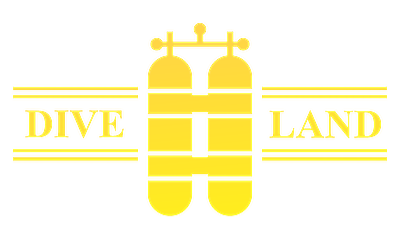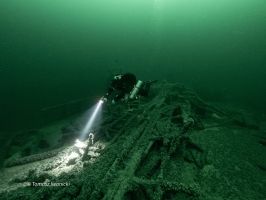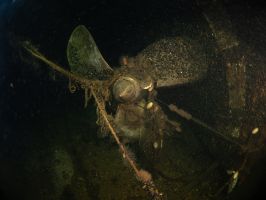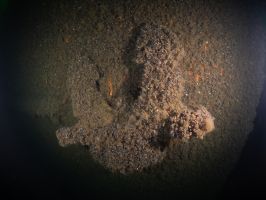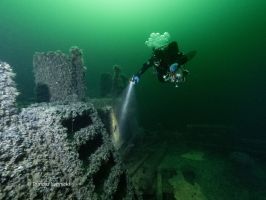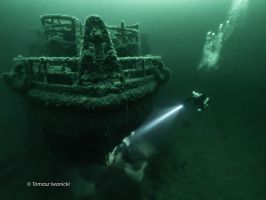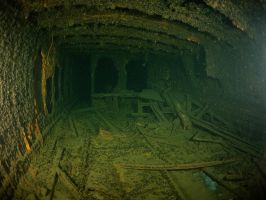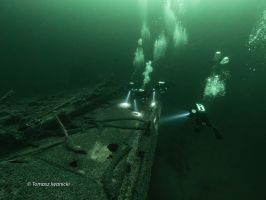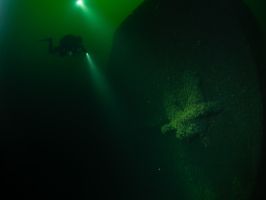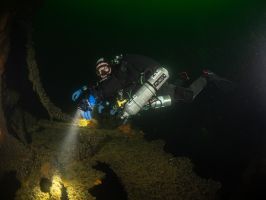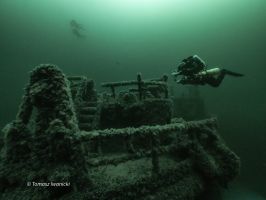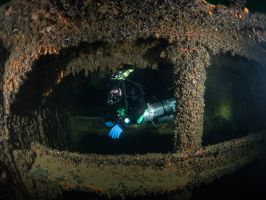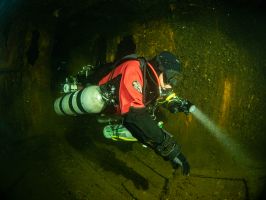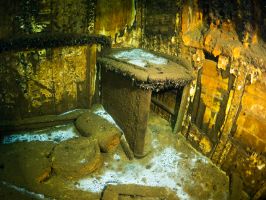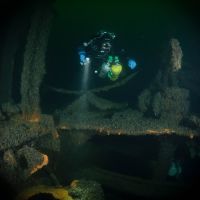Diving on the wrecksite
Terra lies on its keel, on a sandy base and is known as one of the most beautiful wrecks of the Polish sea. The complex geometry of the ship and usually clear visibility in conjunction with an approachable depth of 35-45m are deciding factors in the attractiveness of the dive site.
In its stern part, Terra boasts a superstructure divided by multiple twisting corridors and crew cabins. Parts of inventory, including the armature and the kitchen equipment can be seen from the outside of the wreck. On the top of the quarterdeck you can see open skylights of the engine room through which you can look inside into the large room.
Below the quarterdeck, by the stern you can see two staircases.
By the bottom you can take a look at two turbines.
The main deck is the most ruined. Near the spot that was hit with torpedoes on the starboard, the deck and the sides have collapsed creating a tangling of metal panels, steel lines and cables. With that in mind you can still see elements of deck fixtures: huge cleats, valves and fuel pipes
The bow side is also kept in good condition. It kept its original shape with various decks connected with staircases. Up to this day you can wonder at the masses of pipes that were used to transport fuel. Almost right at the tip of the bow are remains of a unique companionway.
In good weather conditions it’s worthwhile to swim to the bow of Terra and look in awe at the anchors stationed in hawses and it’s tall, majestic bow
Historia
The ship had its launch in 1935 in Rendsburg. The project was overseen by Nobiskrug shipyard, design number 440. The first shipowner Hamburger Tankreederei GmbH stationed in Hamburg, chose the ships main role as transporting petrol and other liquid cargo around the Baltic and North seas. The tanker had the name Gustav Schindler back then. In 1938 the ship was renamed to Oelschindler.
The vessel was incorporated into the Kriegsmarine a short time before the outbreak of WW2. At that time it got a new name, known to this day - Terra.
Its Navy service began as An auxiliary tanker in Kiel shipyard. The unit was then transferred to Gdynia after the city and it’s port was conquered by German forces. Since 1941 until it’s sinking on 13 November 1944 Terra was working on the Baltic Sea as a tanker and floating workshop supporting the operations of 27th U-boot flotilla. The tanker sunk after being hit with two torpedoes launched by a Soviet submarine. It now rests under the sea, around 22 Nm north from Łeba.
In some internet sources you can find that Terra was sunk by SS Lembit (S-4) but it’s worth noting that on the list of Soviet Navy submarines are listed two separate ships EML Lembit and S-4. There is no further information of Lembit sinking the tanker on one of its 7 patrols. Due to this it can be speculated that it was S-4 that sank Terra.
Technical specifications
Civilian oiler transformed into an auxiliary tanker of the Kriegsmarine and later a tanker and mobile workshop. The ship had a buoyancy of 1533brt, was 74m long and 11.3 meters wide. The draught was 6.4 meters
Text by: Bartosz Słaboń
Translation: Szymon Rydzewski
If you have additional info on the ship or would like to correct the Information on the site - please contact us
